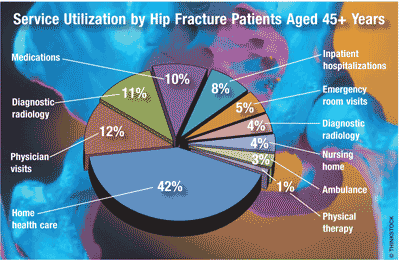US Pharm. 2011;36(10):Epub.
Ninety percent of the 353,000 hip fractures occurring annually in the United States result from a fall. Among people aged 50 years and older who fall, hip fracture occurs two to three times more often in women than in men. In 1996 there were more than 323,000 hospitalizations for hip fractures, translating to more than 850 fractures per day. Most hip fractures occur in older women, and nearly half of women reaching 90 years of age have experienced a hip fracture. Studies have shown that, for tall women ( >5´8˝), the risk of hip fracture is twice that of short women (<5´2˝), and women who have broken an arm are at increased risk for breaking a hip. Many experts predict an epidemic of hip fractures as the population ages, and the CDC estimates that the number could reach 650,000 annually (1,800/day) by 2050.

Consequences: Most patients who fracture a hip require assistance from their family or home care. All hip fracture patients require walking aids for several months, and 51% need a cane or walker permanently. The total annual cost, including lost income, for hip fractures is $12.6 billion ($37,000/fracture). About 220,000 total hip replacements were performed in 2003, according to the National Hospital Discharge Survey. The Report of the Surgeon General suggests that 25% of hip fracture patients recover fully, 40% require nursing home care, and 51% of those aged 65 and older are discharged to a long-term care facility.
Contributing Factors: Osteoporosis, which affects 28 million Americans, causes an estimated 1.5 million bone fractures per year. Generally, individuals who are vulnerable to hip fracture have a poor nutritional intake, are physically and mentally impaired, and have a family history of fractures in later life. In their lifetime, women ultimately lose 30% to 50% of their bone density, and men lose 20% to 30%. Postmenopausal women lose bone calcium at an accelerated pace. White postmenopausal women have a 15% chance of fracturing a hip, and the lifetime risk is expected to increase for all ethnic groups as the population ages.
Commentary: It is incumbent upon the pharmacist to provide lifestyle and therapeutic guidelines to prevent bone loss and fractures in individuals who are most vulnerable. Pharmacists should encourage bone-density testing in women aged 65 years and older and in men who are receiving therapies that may cause bone loss. Falls account for 50% of fractures; therefore, if a patient has low bone density, the pharmacist should counsel him or her about safety measures for preventing falls.
To comment on this article, contact rdavidson@uspharmacist.com.






